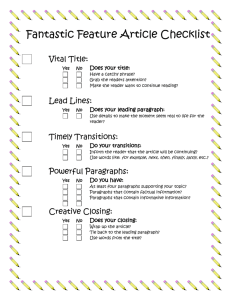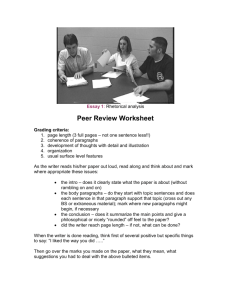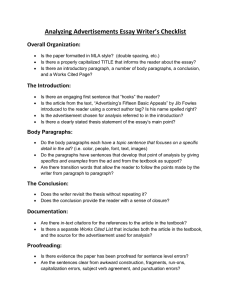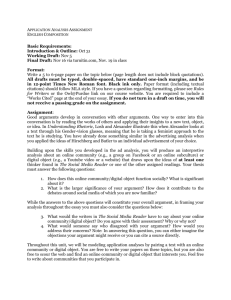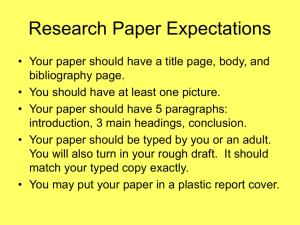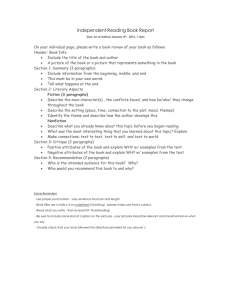APP bookmarks
advertisement
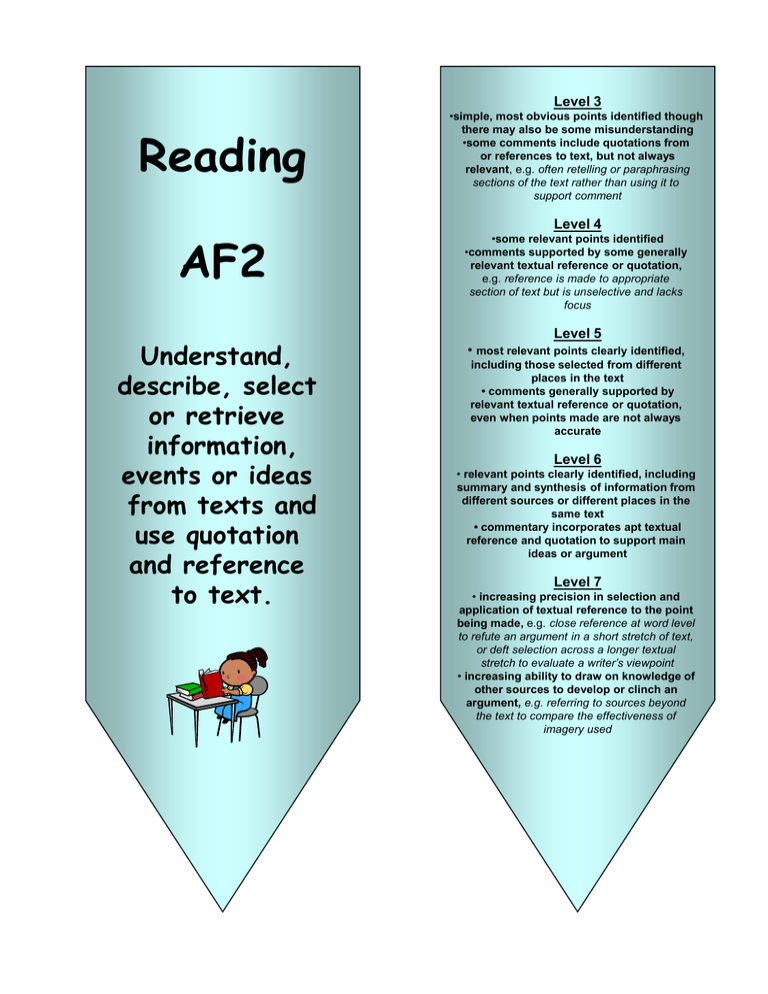
Level 3 Reading AF2 Understand, describe, select or retrieve information, events or ideas from texts and use quotation and reference to text. •simple, most obvious points identified though there may also be some misunderstanding •some comments include quotations from or references to text, but not always relevant, e.g. often retelling or paraphrasing sections of the text rather than using it to support comment Level 4 •some relevant points identified •comments supported by some generally relevant textual reference or quotation, e.g. reference is made to appropriate section of text but is unselective and lacks focus Level 5 • most relevant points clearly identified, including those selected from different places in the text • comments generally supported by relevant textual reference or quotation, even when points made are not always accurate Level 6 • relevant points clearly identified, including summary and synthesis of information from different sources or different places in the same text • commentary incorporates apt textual reference and quotation to support main ideas or argument Level 7 • increasing precision in selection and application of textual reference to the point being made, e.g. close reference at word level to refute an argument in a short stretch of text, or deft selection across a longer textual stretch to evaluate a writer’s viewpoint • increasing ability to draw on knowledge of other sources to develop or clinch an argument, e.g. referring to sources beyond the text to compare the effectiveness of imagery used Level 3 Reading AF3 Deduce, infer or interpret information, events or ideas from texts. •responses show meaning established at a literal level, but little sense of meanings beyond this, e.g. “the pike lives in a big pond in England” • straightforward comment based on a single point of reference in the text, e.g. “he was upset because he was crying” • responses based on personal speculation rather than reading of the text, e.g. when asked what a character is feeling, the response may be based on what they personally would be feeling rather than the character in the text Level 4 • comments make inferences based on evidence from different points in the text, e.g. interpreting a character’s motive from their actions at different points • inferences often correct, but comments are not always rooted securely in the text or repeat narrative or content Level 5 • comments develop explanation of inferred meanings drawing on evidence across the text, e.g. “you know her dad was lying because earlier she saw him take the letter” • comments make inferences and deductions based on textual evidence, e.g. in drawing conclusions about a character’s feelings on the basis of their speech and actions Level 6 • comments securely based in textual evidence and identify different layers of meaning, with some attempt at detailed exploration of them, e.g. explaining the association of different words in an image, or exploring connotations in a political speech or advertisement • comments consider wider implications or significance of information, events or ideas in the text, e.g. tracing how details contribute to overall meaning Level 7 • comments begin to develop an interpretation of the text(s), making connections between insights, teasing out meanings or weighing up evidence Level 3 Reading • a few basic features of organisation at text level identified, with little or no linked comment, e.g. “it tells you all the different things you can do at the zoo” Level 4 AF4 • some structural choices identified with simple comment, e.g. “he describes the accident first and then goes back to tell you why the child was in the road” • some basic features of organisation at text level identified, e.g. “the writer uses bullet points for the main reasons” Level 5 Identify and comment on the structure and organisation of texts, including grammatical and presentational features at text level. • comments on structural choices show some general awareness of author’s craft, e.g. “it tells you all things burglars can do to your house and then the last section explains how the alarm protects you” • various features relating to organisation at text level, including form, are clearly identified, with some explanation, e.g. “each section starts with a question as if he’s answering the crowd” Level 6 • some detailed exploration of how structural choices support the writers’ theme or purpose, e.g. tracing how main ideas/characters develop over the text as a whole • comment on how a range of features relating to organisation at text level contribute to the effects achieved, e.g. how the writer builds up to an unexpected ending, juxtapose ideas, changes perspectives or uses everyday examples to illustrate complex ideas Level 7 • some evaluation of the extent to which structural choices support the writers’ theme or purpose • some appreciation of the skill with which a range of features relating to organisation at text level are used Level 3 Reading AF5 Explain and comment on writers’ use of language, including grammatical and literary features at word and sentence level. •a few basic features of writer’s use of language identified, but with little or no comment, e.g. “there are lots of adjectives” or “he uses speech marks to show there are lots of people there” Level 4 • some basic features of writers’ use of language identified, e.g. “all the questions make you want to find out what happens next” • simple comments on writer’s choices, e.g. “ ‘disgraceful’ is a good word to use to show he is upset” Level 5 • various features of writers’ use of language identified, with some explanation, e.g. “when it gets to the murder they speak in short sentences and quickly which makes it more tense” • comments show some awareness of the effect of writers’ language choices, e.g. “ ‘inked up’ is a good way of describing how the blackberries go a bluey black colour as they ripen” Level 6 • some detailed explanation, with appropriate terminology, of how language is used, e.g. tracing an image; identifying and commenting on patterns or structure in the use of language; or recognising changes in language use at different points in a text • some drawing together of comments on how the writers’ language choices contribute to the overall effect on the reader, e.g. “all the images of flowers make the events seem less horrific and makes it even sadder” Level 7 • comments begin to develop precise, perceptive analysis of how language is used • some appreciation of how the writer’s language choices contribute to the overall effect on the reader Level 3 Reading • comments identify main purpose, e.g. “the writer doesn’t like violence” • express personal response but with little awareness of writers’ viewpoint or effect on reader, e.g. “she was just horrible like my nan is sometimes” Level 4 AF6 Identify and comment on writers’ purposes and viewpoints, and the overall effect of the text on the reader. • main purpose identified, e.g. “it’s all about why going to the dentist is important and how you should look after your teeth” • simple comments show some awareness of writers’ viewpoint, e.g. “he only tells you good things about the farm and makes the shop sound boring” • simple comment on overall effect on reader, e.g. “the way she describes him as ‘ratlike’ and ‘shifty’ makes you think he’s disgusting” Level 5 • main purpose clearly identified, often through general overview, e.g. “the writer is strongly against war and wants to persuade the reader to agree” • viewpoint in texts clearly identified, with some, often limited, explanation, e.g. “at the end he knows he’s done wrong and makes the snake sound attractive and mysterious” • general awareness of effect on the reader, with some, often limited explanation, e.g. “you’d be persuaded to sign up because 25p a week doesn’t seem that much to help someone see” Level 6 • evidence for identifying main purpose precisely located at word/sentence level or traced through a text • viewpoint clearly identified and explanation of it developed through close reference to the text • the effect on the reader clearly identified, with some explicit explanation as to how that effect has been created Level 7 • responses begin to develop some analytic or evaluative comment on author’s purpose • responses begin to develop some analytic or evaluative comment on how viewpoint is established or managed across a text • responses begin to develop an appreciation of how particular techniques and devices achieve the effects they do Level 3 Writing AF5 Vary sentences for clarity, purpose and effect. • reliance mainly on simple sentences • and, but, so are the most common connectives • some limited variation in use of tense and Verb forms, not always secure Level 4 • some attempt to vary length, structure and subject of sentences • use of some subordinating connectives, e.g. if, when, because • some variation, generally accurate, in tense and verb forms Level 5 • a variety of sentence lengths, structures and subjects provides clarity and emphasis • wider range of connectives used to clarify relationship between ideas, e.g. although, on the other hand, meanwhile • some features of sentence structure used to build up detail or convey shades of meaning, e.g. variation in word order, modals in verb phrases Level 6 • controlled use of a variety of simple and complex sentences to achieve purpose and contribute to overall effect • confident use of a range of sentence features to clarify or emphasise meaning, e.g. fronted adverbials (“Reluctantly, he…”, “Five days later, it…”), complex noun or prepositional phrases Level 7 • variety of sentence types deployed judiciously across the text to achieve purpose and overall effect, with rare loss of control • a range of features employed to shape/craft sentences that have individual merit and contribute to overall development of the text, eg embedded phrases and clauses that support succinct explanation; secure control of complex verb forms; antithesis, repetition or balance in sentence structure Level 3 Writing • straightforward sentences usually demarcated accurately with full stops, capital letters, question and exclamation marks • comma splicing evident, particularly in narrative • some, limited, use of speech punctuation AF6 • sentences demarcated accurately throughout the text, including question marks • speech marks to denote speech generally accurate, with some other speech punctuation • commas used in lists and occasionally to mark clauses, although not always accurately Level 4 Level 5 Write with technical accuracy of syntax and punctuation… • full range of punctuation used accurately to demarcate sentences, including speech punctuation • syntax and punctuation within the sentence generally accurate including commas to mark clauses, though some errors occur where ambitious structures are attempted Level 6 • syntax and full range of punctuation are consistently accurate in a variety of sentence structures, with occasional errors in ambitious structures, e.g. only occasional comma splices; some use of semicolons, not always accurate Level 7 • variety of sentence types deployed judiciously across the text to achieve purpose and overall effect, with rare loss of control • a range of features employed to shape/craft sentences that have individual merit and contribute to overall development of the text, eg embedded phrases and clauses that support succinct explanation; secure control of complex verb forms; antithesis, repetition or balance in sentence structure Level 3 Writing • some limited attempt to organise ideas with some related points placed next to each other • openings and closings usually signalled • some attempt to sequence ideas or material logically, not always successful Level 4 AF3 • ideas are organised by clustering related points or by time sequence • ideas are organised simply, with a fitting opening and closing, sometimes linked • ideas or material generally in logical sequence but overall direction of writing often not clearly signalled Level 5 Organise and present whole texts effectively… • material is structured clearly, with sentences organised into appropriate paragraphs • development of material is effectively managed across text, e.g. closings refer back to openings • overall direction of the text supported by clear links between paragraphs Level 6 • material is clearly controlled and sequenced, taking account of the reader’s likely reaction, e.g. paragraphs of differing lengths, use of flashback in narrative, anticipating reader’s questions • a range of features clearly signal overall direction of the text for the reader, e.g. opening paragraphs that introduce themes clearly, paragraph markers, links between paragraphs Level 7 • information, ideas and events skilfully managed and shaped to achieve intended purpose and effect, e.g. introduction and development of character, plot, event , or the terms of an argument, are paced across the text • a variety of devices position the reader, e.g. skilful control of information flow to reader; teasing the reader by drawing attention to how the narrative or argument is being handled Level 3 Writing AF4 Construct paragraphs and cohesion within and between paragraphs. • some paragraphs/sections often lacking internal structure, e.g. one-sentence paragraphs or Ideas randomly organised • within paragraphs/sections, some limited attempt to link sentences, e.g. use of pronouns, often inconsistent, or of adverbials • movement between paragraphs/sections abrupt or disjointed Level 4 • paragraphs/sections help to organise content, e.g. main idea usually supported or elaborated by following sentences • within paragraphs/sections, limited range of connectives between sentences, e.g. over use of “also” or pronouns • some attempts to establish simple links between paragraphs/sections not always maintained, e.g. firstly, next Level 5 • paragraphs clearly structure main ideas across text to support purpose, e.g. clear chronological or logical links between paragraphs • within paragraphs/sections, a range of devices support cohesion, e.g. secure use of pronouns, connectives, references back to text • links between paragraphs/sections generally maintained across whole text Level 6 • construction of paragraphs clearly supports meaning and purpose, e.g. paragraph topic signalled and then developed, withholding of information for effect, thematic links between paragraphs • within paragraphs, cohesive devices contribute to emphasis and effect, e.g. adverbials as sentence starters Level 7 • paragraphing across the text is integral to meaning and purpose • individual paragraphs shaped or crafted for imaginative or rhetorical effect Level 3 Writing • some appropriate ideas and content included • some attempt to elaborate on basic information or events, e.g. nouns expanded by simple adjectives • attempt to adopt viewpoint, though often not maintained or inconsistent, e.g. attitude expressed, but with little elaboration Level 4 AF1 Write imaginative, interesting and thoughtful texts. • relevant ideas and content chosen • some ideas and material developed in detail, e.g. descriptions elaborated by adverbial and expanded noun phrases • straightforward viewpoint generally established and maintained, e.g. writing in role or maintaining a consistent stance Level 5 • relevant ideas and material developed with some imaginative detail • development of ideas and material appropriately shaped for selected form • clear viewpoint established, generally consistent, with some elaboration, e.g. some, uneven, development of individual voice or characterisation in role Level 6 • imaginative treatment of appropriate materials, familiarity with conventions of a variety of forms, adapting them when needed to suit purpose and audience, not always successfully • convincing, individual voice or point of view established and mostly sustained throughout • level of formality used for purpose and audience generally appropriate and a range of stylistic devices used to achieve effect, not always successfully Level 7 • imaginative and generally successful adaptation of wide range of forms and conventions to suit variety of purposes and audiences • well judged, distinctive individual voice or point of view established and sustained throughout • generally successful and consistent control of appropriate level of formality and varied range of stylistic devices to achieve intended effect Level 3 Writing • some attempt to establish purpose, though often superficial • some features of selected form are signalled to the reader • some attempt to establish appropriate style but not always consistent or sustained AF2 • main purpose of writing is clear but not always consistently maintained • main features of selected form are clear and appropriate to purpose • style generally appropriate to task, though awareness of reader not always sustained Level 4 Level 5 Produce texts which are appropriate to task, reader and purpose. • main purpose of writing is clear and consistently maintained • features of selected form clearly established with some adaptation to purpose • appropriate style clearly established to maintain reader’s interest throughout Level 6 • imaginative treatment of appropriate materials, familiarity with conventions of a variety of forms, adapting them when needed to suit purpose and audience, not always successfully • convincing, individual voice or point of view established and mostly sustained throughout • level of formality used for purpose and Audience generally appropriate and a range of stylistic devices used to achieve effect, not always successfully Level 7 • imaginative and generally successful adaptation of wide range of forms and conventions to suit variety of purposes and audiences • well judged, distinctive individual voice or point of view established and sustained throughout • generally successful and consistent control of appropriate level of formality and varied range of stylistic devices to achieve intended effect Level 3 Writing AF7 Select appropriate and effective vocabulary. • simple, generally appropriate, vocabulary used, though often limited in range • some attempt to use words for effect Level 4 • some evidence of deliberate vocabulary choices • some expansion of general vocabulary to match topic Level 5 • vocabulary chosen for effect • reasonably wide vocabulary used, though not always appropriately Level 6 • vocabulary chosen generally appropriate to purpose and audience • range of vocabulary generally varied and often ambitious, even though choices not always apt Level 7 • vocabulary consistently, often imaginatively, well matched to purpose and audience • range of vocabulary generally varied and ambitious, often judiciously chosen Across a range of writing, correct spelling of: Writing AF8 Use correct spelling. Level 3 • sometimes, common grammatical function words, e.g. with, could Likely errors: • frequent phonetically plausible spelling in content words, eg veiw, recieve, corse, thort • frequently in inflected endings, e.g. -es, -ed, -ies, -ied, -er, -est, -ier, -iest, -ing Level 4 • most common grammatical function words, e.g. you, because, although • most adverbs with –ly formation Likely errors: • homophones of common grammatical function words, e.g. they’re/their/ there, of/have/off • occasional phonetically plausible spelling in content words, e.g. board, acsept, hungrey, teryfing • occasional inflected words, e.g. -es, -ed, -ies, -ied, -er, -est, -ier, -iest, -ing Level 5 • common grammatical function words consistently • almost all inflected words • most derivational suffixes, e.g. -ion, ise, -al/ial, -able/ible • most prefixes, e.g. disappear, uncertain, exclaim Likely errors: • occasional phonetically plausible spelling in content words, e.g. board, acsept, hungrey, teryfing • double consonants in prefixes, e.g. irregular, unnecessary Level 6 • generally correct spelling throughout Likely errors: • occasional errors in ambitious or complex words Level 7 • correct spelling throughout, including of ambitious or complex words When demonstrating my ability in assessment focus 2 to: understand, describe, select or retrieve information, events or ideas from texts and use quotation and reference to text to progress to level 3, I need to: • identify the simple, most obvious points as often as possible • make some comments including quotations from or references to text to progress to level 4, I need to: • identify some relevant points • support my comments using some generally relevant textual reference or quotation to progress to level 5, I need to: • clearly identify the most relevant points in a text, including those selected from different places • generally support comments by giving relevant textual reference or quotation to progress level 6, I need to: •clearly identify relevant points, including summary and synthesis of information from different sources or different places in the same text •incorporate apt textual reference and quotation in my commentary to support main ideas or argument to progress level 7, I need to: • select and apply, with increasing precision, textual reference to the point being made, eg close reference at word level to refute an argument in a short stretch of text, or, deft selection across a longer textual stretch to evaluate a writer’s viewpoint •draw on knowledge of other sources with increasing ability to develop or clinch an argument, eg referring to sources beyond the text to compare the effectiveness of imagery used


